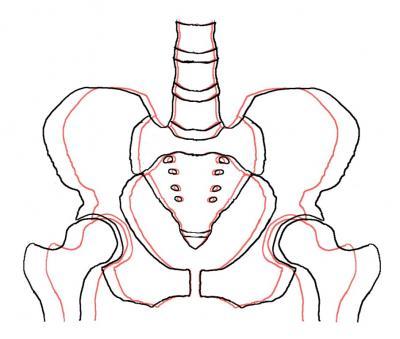CHAPEL HILL, N.C. – By the age of 20, most people have reached skeletal maturity and do not grow any taller. Until recently it was assumed that skeletal enlargement elsewhere in the body also stopped by age 20.
But a new study by researchers at the University of North Carolina at Chapel Hill has found evidence that, even though you're not getting taller anymore, the pelvis ("hipbones") does continue to widen as people advance in age from 20 years to 79 years.
"I think it's a fairly common human experience that people find themselves to be wider at the age of 40 or 60 then they were at 20," said Laurence E. Dahners, MD, senior author of the study and a professor in the Department of Orthopaedics in the UNC School of Medicine. "Until recently we assumed that this was caused simply by an increase in body fat.
"Our findings suggest that pelvic growth may contribute to people becoming wider and having a larger waist size as they get older, whether or not they also have an increase in body fat," Dahners said.
The pelvic width of the oldest patients in the study was, on average, nearly an inch larger than the youngest patients. This one-inch increase in pelvic diameter, by itself, could lead to an approximately three-inch increase in waist size from age 20 to age 79. If the rest of the body is widening commensurately, this might account for a significant portion of an increase in body weight of about one pound a year that many people experience during the same period, Dahners said.

In this drawing, a 20-year-old's pelvis is represented in pink,and a 79-year-old's pelvis in black. The difference between the two isapproximately one inch in width. Image created by Laurence Dahners, M.D.
(Photo Credit: Laurence E. Dahners, M.D.)
Dahners and his UNC co-authors got the idea for the study, which was published online on May 23, 2011 by the Journal of Orthopaedic Research, after being surprised to see evidence of pelvic widening in X-rays from patients in an unrelated bursitis study. They searched the scientific literature and found no previous studies that directly examined whether or not the skeleton continues to widen after skeletal maturity.
So, they set out to examine that question themselves. They did so by using CT scans from 246 randomly selected patients to measure the width and height of the L4 vertebral body (as an indication of whether these patients were taller and larger overall), the width of the pelvic inlet (the birth canal opening in the middle of the pelvis), the distance between the femoral heads (hip joints) and the diameters of the femoral heads.
There were approximately 20 male and 20 female patients in each 10-year age group, from the 20-29 age group to the 70-79 age group.
Their results confirmed that the width of the pelvis, the width but not the height of L4 vertebral body, the distance between the femoral heads and the diameter of the femoral heads all continued to enlarge after skeletal maturity.
In particular, the fact that the pelvic inlet also widened is evidence of true pelvic growth rather than simple appositional bone formation, Dahners said. The pelvic inlet would be smaller if appositional bone formation were taking place, he said.